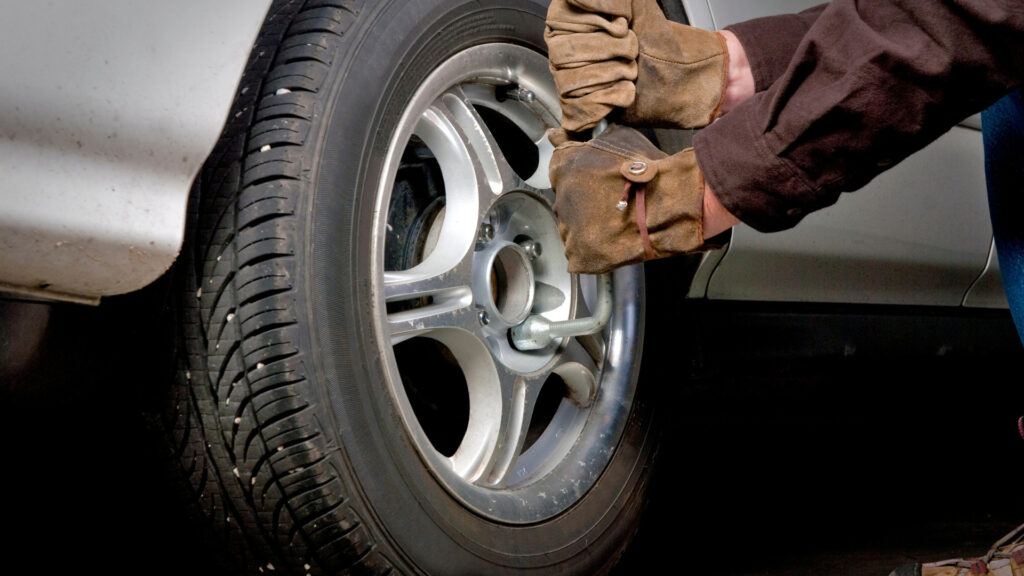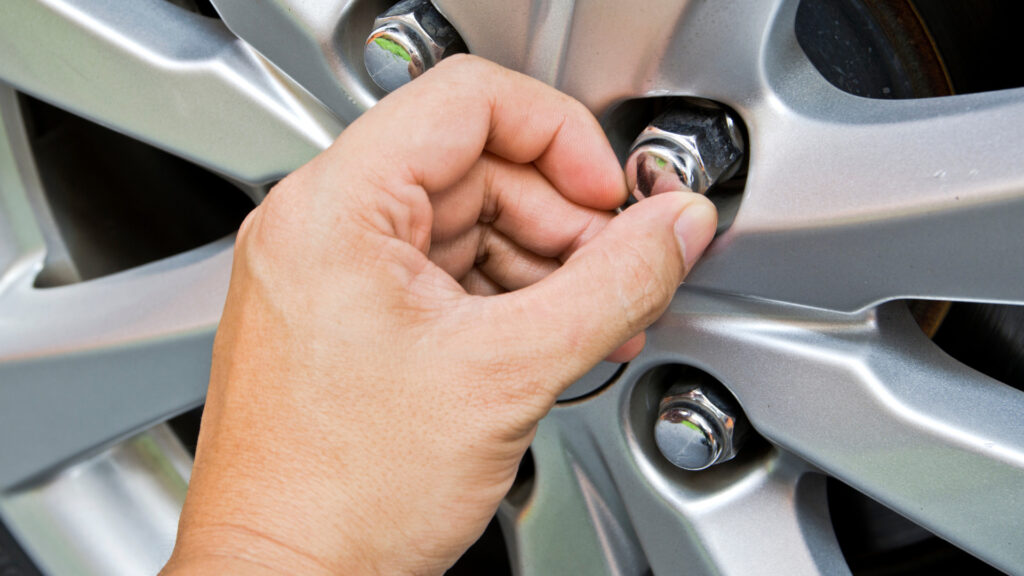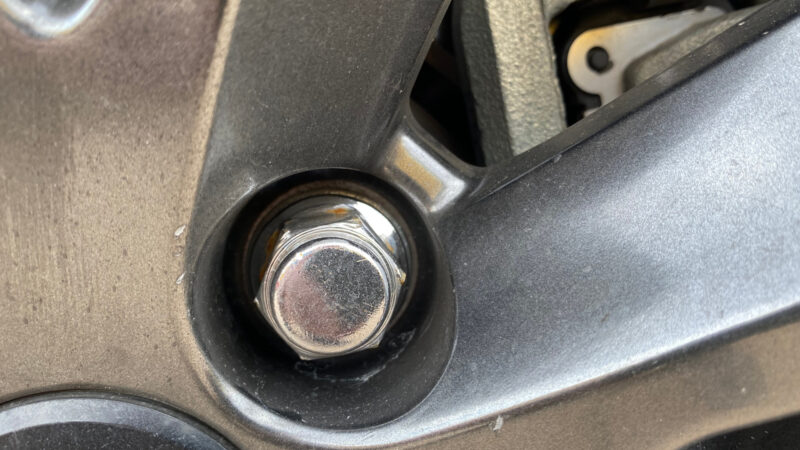Table of Contents Show
You may know many things about your RV, like its dimensions, weight, and how many amp-hours of battery you have. However, do you know the lug nut size on your wheels?
Most RVers don’t learn this vital information until it’s too late. We think it’s one critical detail that every RVer should know.
So how do you know your RV lug nut size? Let’s take a look!
What Is a Lug Nut?
A lug nut keeps your tire attached to your vehicle or trailer as you drive. If it weren’t for lug nuts, the wheels would fly with every bump and turn in the road.
The lug nut screws onto a threaded wheel stud, securing the tire to the axle.
A standard passenger vehicle and RV will have three to five lug nuts, but heavy-duty trucks can have more.
How Do I Know My RV Lug Nut Size?
You typically don’t have to worry about your RV’s lug nut size until you lose or damage one.
The easiest way to check the lug nut size on your RV is to examine the documentation for your RV or contact your RV manufacturer.
They may ask for your VIN, but they’ll find the most accurate information and help you avoid buying the wrong lug nuts for your RV.
However, you might not have the time to wait on hold or for the manufacturer to get back to you. Luckily, there are more options.
The first option is to use a thread pitch gauge.
This simple tool isn’t accurate if you don’t know the thread size, but it allows you to approximate the measurement according to some standard thread sizes.
However, as simple as these tools are, it’s not the easiest method. If you don’t already have one, you’ll have to head to the store. If you’re driving to the store, you might as well try our final method.
The final method is to take one of the other lug nuts to the store. Use the bolts in the store to find the exact match that fits the RV lug nut you bring.
If you can find someone that works at the store, they’ll likely help narrow it down for you and ensure you get the correct lug nut for your RV.
How Do You Measure a Lug Nut Pattern?
To measure a lug nut pattern, you’ll need a caliper. These tools precisely measure the distance between two objects.
- MULTI-FUNCTION: This measuring tool has a quick-change button that changes between three measuring modes such as inch,...
- THREE UNIT CONVERSION: The electronic digital caliper micrometer measurement range is 0” - 6” and 0 mm – 150 mm...
If you’re measuring a wheel with an even number of studs, you’ll measure from the center of one stud to the center of another.
However, if you’re measuring the lug nut pattern on a wheel with an even number of studs, you’ll measure from the center of one stud to the outside edge of the opposite stud.
You can use a tape measure to measure a lug nut pattern size, but it’s not as easy. Curves in the rim or hub cap can make it challenging to use a tape measure.
However, using the caliper provides more flexibility for objects that might be in the way.
Keep in Mind: Are you having trouble with the wiring in your RV? Then it’s time to replace the trailer plug!
How Do I Remove Lug Nuts?
If you need to remove a lug nut, you’ll need some tools. One mistake many RVers make is not carrying the proper tools during their travels.
You typically don’t know when or where you’ll need to remove the lug nuts on a tire. However, most RVers find it rarely happens in an ideal situation.
You can use a four-way wrench, torque wrench, or breaker bar to remove lug nuts. You’ll want to ensure the tire rests firmly on the ground and has the weight of the vehicle or trailer on it.
This will help increase your leverage to get the initial turn of a lug nut. You can use a jack to raise the wheel off the ground once you turn each lug nut a few times.
- Made with heat treated drop-forged steel for increased strength and longevity
- Universal 4-Way Cross Lug Wrench with 4 socket heads to fit the most common SAE lug nuts
- Durable Ratchet Head: Made from Hardened treated Chrome Vanadium steel alloy (Cr-V) Corrosion-Retardant: Satin Finish....
- Easy Storage: A sturdy plastic storage case is included. Non-Slip Grip: Knurled handle
- [LONG REACH]: Half inch drive breaker bar with a long 15-inch handle that provides ample leverage to amplify torque.
- [DURABLE]: Made of extremely durable drop forged heat-treated chrome vanadium and corrosion-resistant mirror/chrome...

How Tight Should Trailer Wheel Nuts Be?
How tight you should tighten your lug nuts will depend on the size of your studs.
You would typically tighten trailer wheel nuts to 90 to 160-foot pounds. This will require a torque wrench to ensure you’re not tightening your wheel nuts too much.
Lugs that are 0.5 inches require 90 to 120-foot pounds, 0.5625 inches require 120 to 140-foot pounds, and 0.625-inch lugs require 140 to 160-foot pounds.
Manufacturers usually include the recommended torquing in the documentation for a trailer.
Keep in Mind: Having a tool kit while on the road will help for any repairs that you may arise! Before you hit the road, make sure you have these 25 Valuable RV Tool Kit Items!
Where Can I Buy Replacement RV Lug Nuts?
You can buy replacement RV lug nuts at almost any auto parts store. If you can bring one of your RV lug nuts to the store, this will help them identify the correct sizing.
If you’re confident you know which RV lug nuts to order, you can purchase them online through Amazon or other online retailers.
Even if you only need a single lug nut, it’s best to buy a few extras. You never know when you’ll need them!

Is Knowing My RV Lug Nut Size Important?
Knowing the size of your lug nuts is essential, especially if you ever need to remove them. However, most RVs use 0.5-inch lug nuts. You shouldn’t hit the road without getting a 0.5-inch socket and torque wrench.
Many RVers don’t realize that you should check the torque on your lug nuts before every trip. RVers rarely check the torque on their lug nuts unless there’s a problem with one of their tires.
Do yourself a favor, and check your RV lug nut size before hitting the road on your next trip!
Do you know your RV lug nut size?
Last update on 2025-01-19 / Affiliate links / Images from Amazon Product Advertising API










